A large part of cruising on America’s Great Loop includes traveling on waterways with locks. In this post, we discuss how to lock a boat and all of the tips and tricks we’ve learned along the way, including what a lock is, the gear needed, how to lock a boat, our five steps to locking, the locking agencies, the cost of locking a boat, and how to communicate with a lock mater!
Depending upon what part of the country you typically boat in, locks might be a completely new experience to navigate. We share all of our tips and tricks on navigating a lock safely and successfully. Before starting the loop, we didn’t know anything about locks. But we learned a tremendous amount after completing over 100 locks. We hope this article helps calm your nerves about locking, all of the Locking 101 information on what you can expect, and what precautions to take for a safe locking experience.
Note: We use affiliate links which provide us a little kickback each time you use one of our links and make a purchase, without any additional cost to you. We do not recommend products that we don’t already love or have heard great things about, so you can trust we’re only suggesting great products to you.
FREE Locking Checklist
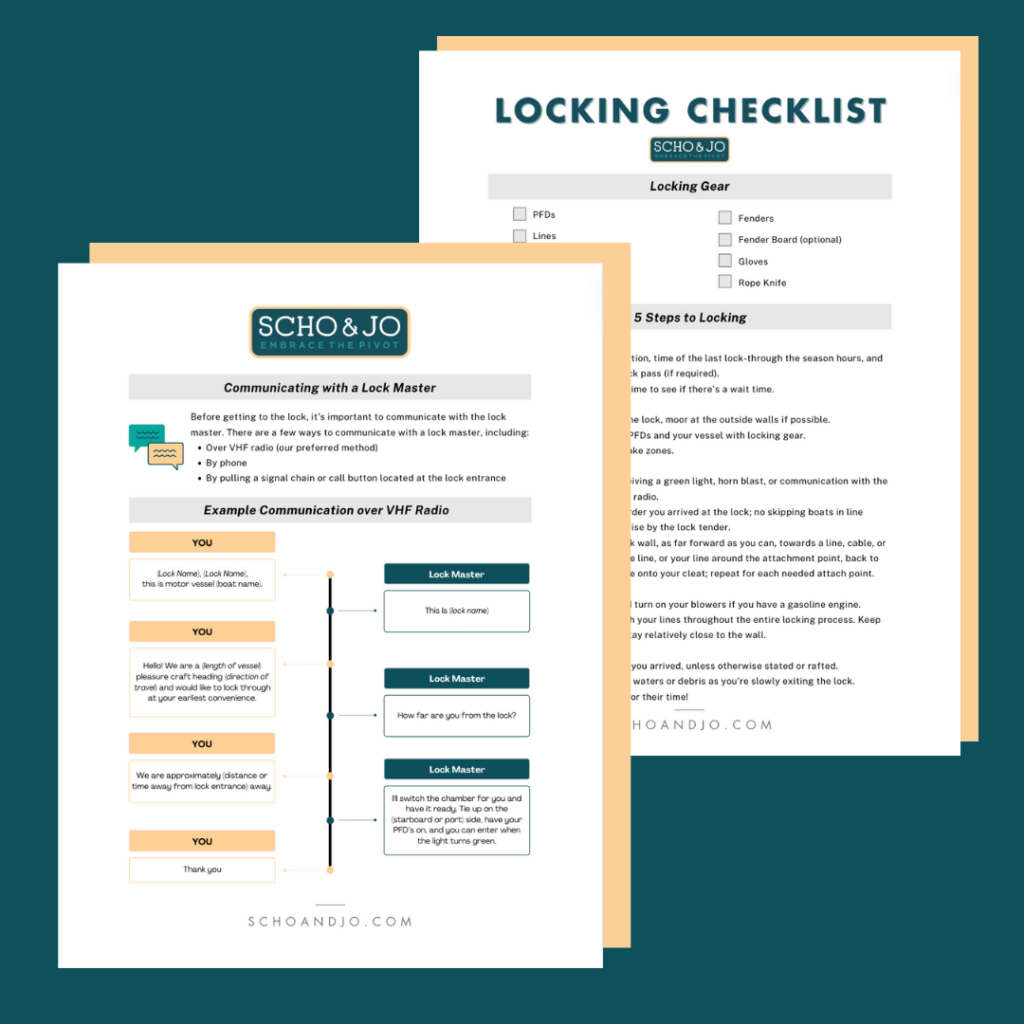
Download our FREE LOCKING CHECKLIST to keep at your help station for your own boating adventures.
WHAT IS A LOCK
Let us begin with a brief overview of what is a lock. A lock is a device used for raising boats between different water levels on river and canal waterways. Locks are designed to give water traffic a consistent and safe transfer both up and downstream. On America’s Great Loop you may traverse across a few very different styles of locks. Some manually operated with a turnstile, some lift your boat in the air in a chamber, and one that even carries your vessel over a road. The sizes of locks vary from smaller locks around 100 feet to commercial locks that are about 1,000 feet long and almost 100 feet tall.

LOCKING GEAR
Much of the gear we’re including here, you probably already have on your boat. Since much of the gear and techniques are similar to docking a boat. However, we have included them here as checks and balances. We also included gear specific to emergencies while locking.
PERSONAL FLOTATION DEVICE (PFD’s)
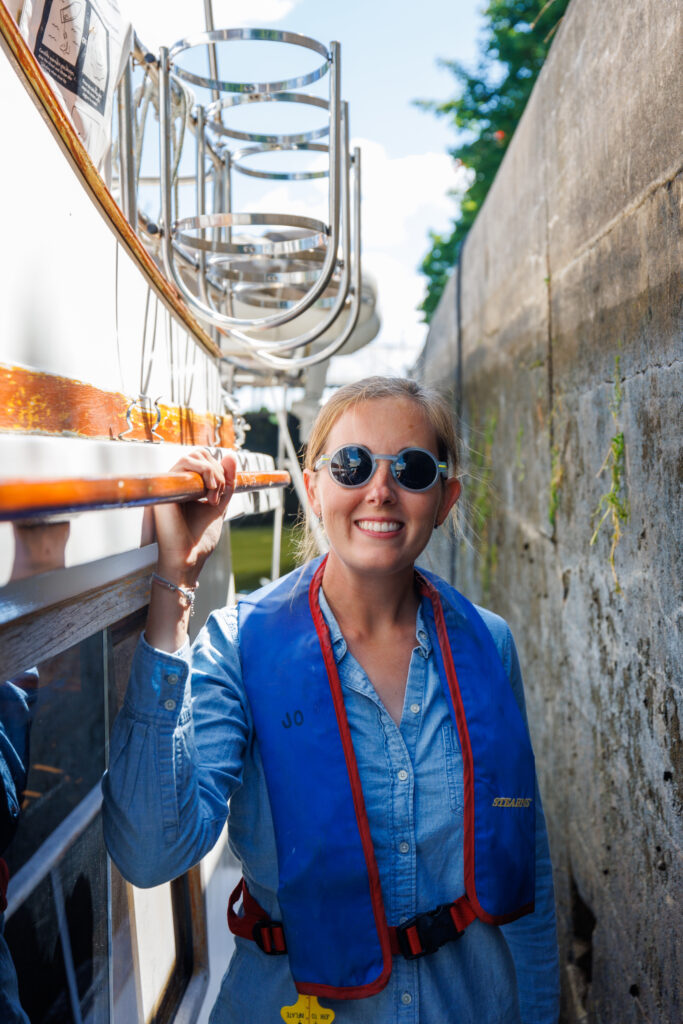
Not all waterways require you to wear your PFD’s in a lock. However, it’s a good practice to have it close by. In our experience, we found that they were required in all US Army Corp of Engineer Locks. We have PFD’s that were given to us and work great. If you are shopping for new PFD’s, then we’ve heard great reviews about Mustang PFDs.
LINES
Lines are how you’ll attach to the lock walls, bollards, or cables in every lock. Depending upon the size of your boat, you might need one line on the bow and one line on the stern. Or just one line on a midship cleat. To store our lines between locks, we neatly hang our lines on the railings. The thickness of your lines should correlate with the size of your boat. We use 5/16” lines for our 20-ton trawler.
As we cruised through the waterways with locks and expected to go through a few locks in one day, we kept one line on each cleat that we neatly tied to our handrails for ease of access during the locking process. This made it easy to quickly remove the line and have it ready for the lock.
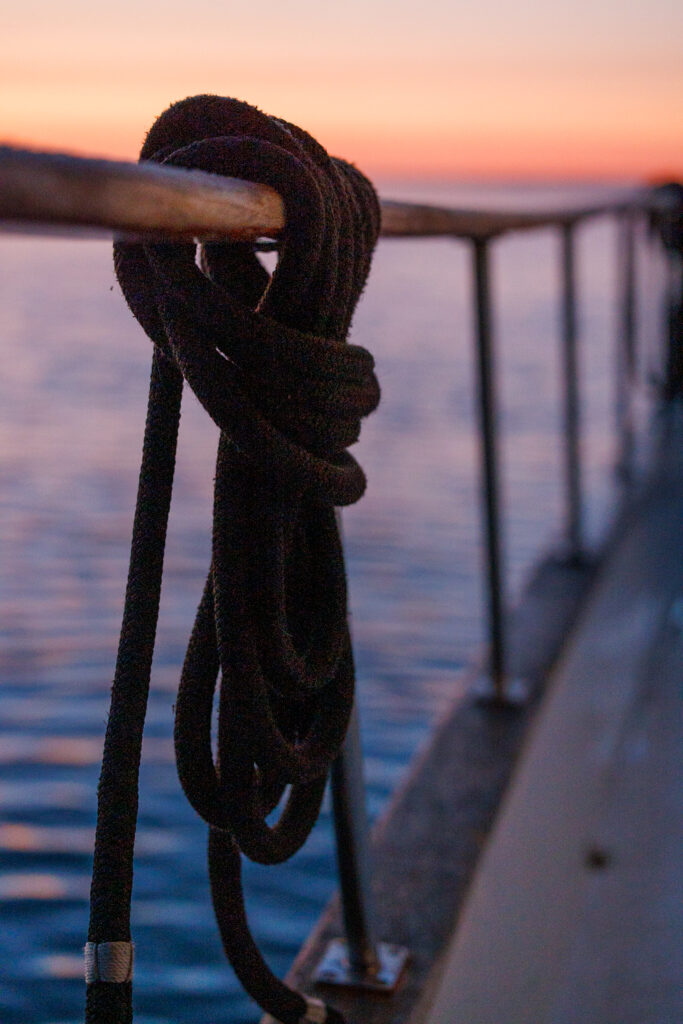
FENDERS
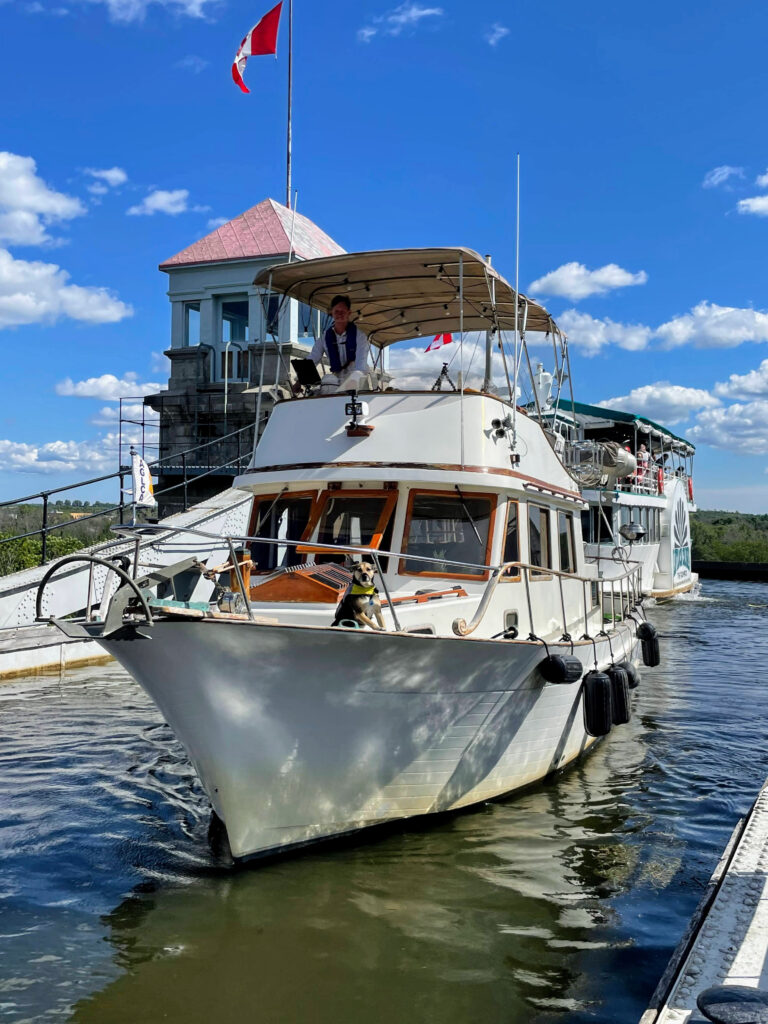
The number of fenders you will need corresponds to the size of your boat and the size of the fenders. Boats are usually moving and rotating in the lock due to the motion of the water being pumped into or out of the lock.
Turbulence can cause the boats in the chamber to move quite a bit. Which is why you’ll want to protect your boat with fenders. While living on our boat, we have six of these Taylor Made black fenders, which we really liked. We like that they have a center rope tube, which allows us to go from a vertical alignment to a horizontal one quickly.
Throughout our Great Loop journey, we saw many boats with large ball fenders arranged near the front of the boat. It’s a juggling act between having enough fenders but not too many. Because you’ll have to store them when you’re not using them. When we’re not using our fenders, they’re stored in these Taylor Made boat fender racks. We use lines to attach our fenders to our railings. But we’ve also seen boats use a variety of adjuster clips.
FENDER BOARD OR FENDER COVERS
A fender board is a piece of wood attached to your fenders to protect them. They provide more surface area on the lock wall. On our Loop, we didn’t need a fender board. However, we saw many boats use one to cover their fenders, protecting their boats against dirt, algae, and grime in the locks. Boat US includes a great tutorial on creating your own DIY fender board. This could help lower the amount of boat maintenance required.
An alternative to a fender board could include fender covers, which need to be washed every so often and are a more expensive option. Fleece fender covers keep your fenders nice and clean but require you to wash them every so often.
Photo courtesy of BoatUS.
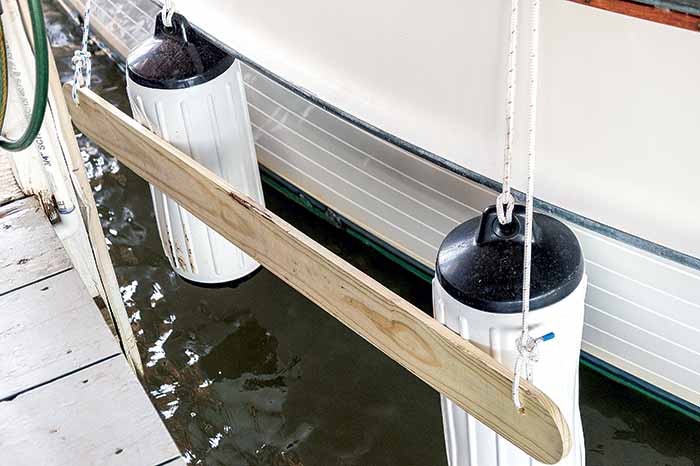
GLOVES

We bought yellow dish gloves prior to starting the New York State Canals based on our friend’s recommendation. They really saved our hands from constantly getting gross from the grime, algae, and dirt that covers the New York State Canal lines. These reusable latex gloves worked great for us. Alternatively, we also saw boaters using work gloves which are more heavy-duty for the locks. Either works fine.
ROPE KNIFE
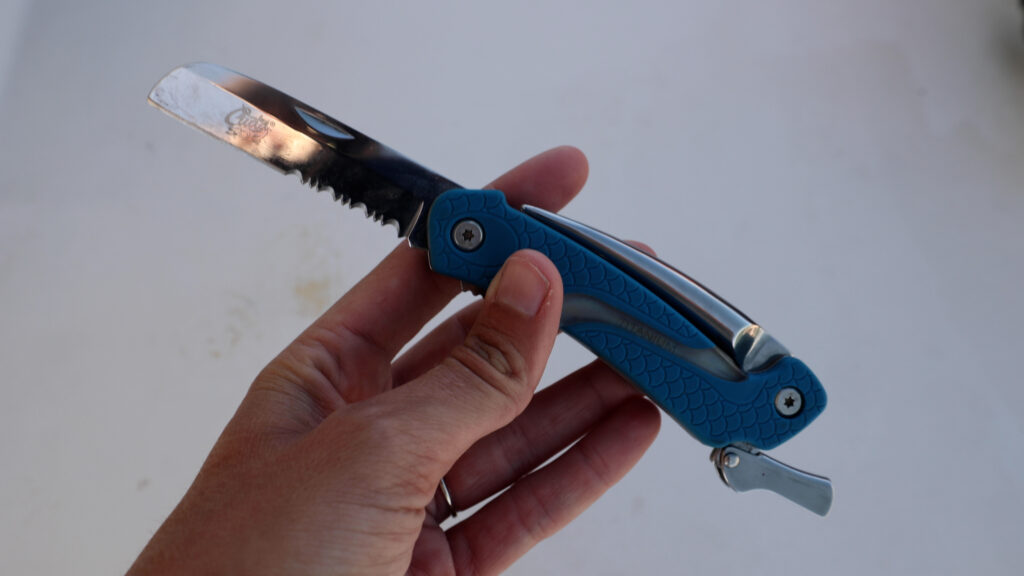
A rope knife is one of the most important safety tools to have while locking! Having a boat knife on your body and ready (not in a drawer stowed away somewhere) for an emergency is critical. This is in case your lines get stuck and you need to cut your lines. As a boat is moving through a lock and the water is rising or lowering, there’s an opportunity for the vessel to get caught on the lines and get stuck on the wall. In this case, you will need to cut the rope preventing long-term damage to your vessel. Thankfully, we’ve never experienced this ourselves, but have heard several stories from other boaters and loopers of this happening. This is the rope knife we have aboard PIVOT, but I’m sure any will work.
BOAT POLE
We have two boat poles on PIVOT that we constantly use throughout the locking process. We keep one at the bow and one at the stern. There are many things that we’ve benefitted from our previous owner’s decision. And having two boat poles would be one of them. Boat poles are used basically as an extension of yourself. We’ve used them to grab a far away lock-rope, pass a line to a lock tender, as well as simply help fend off our boat from the lock wall.
These would make for a great gift for boaters if you are looking for ideas!
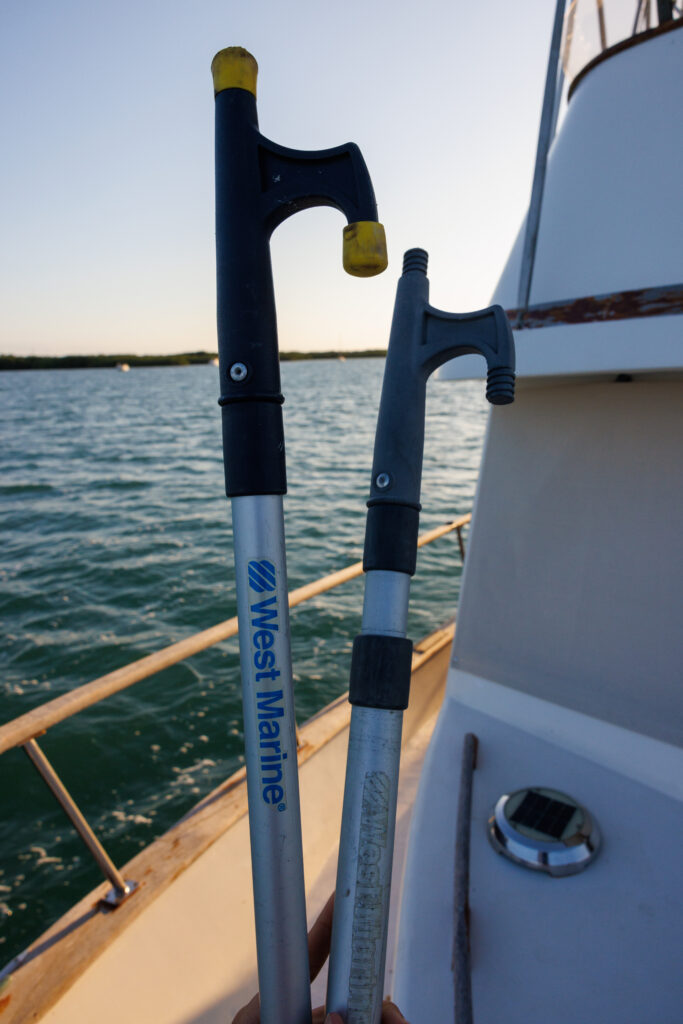
VHF RADIO
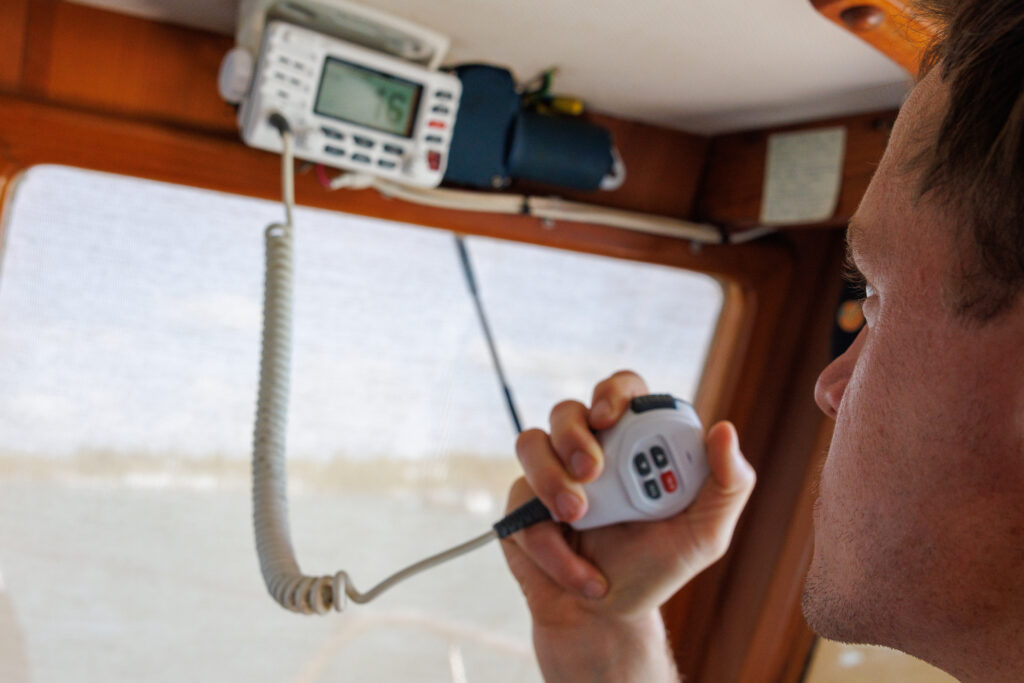
This last item may seem obvious, but having your VHF Radio on and at the ready is critical to a successful locking. While not all locks communicate over the radio, it is important to be able to communicate with other boats. The channel on which a lock listens varies by locking system. Normally we will dual-watch, channel 16 with the locking channel.
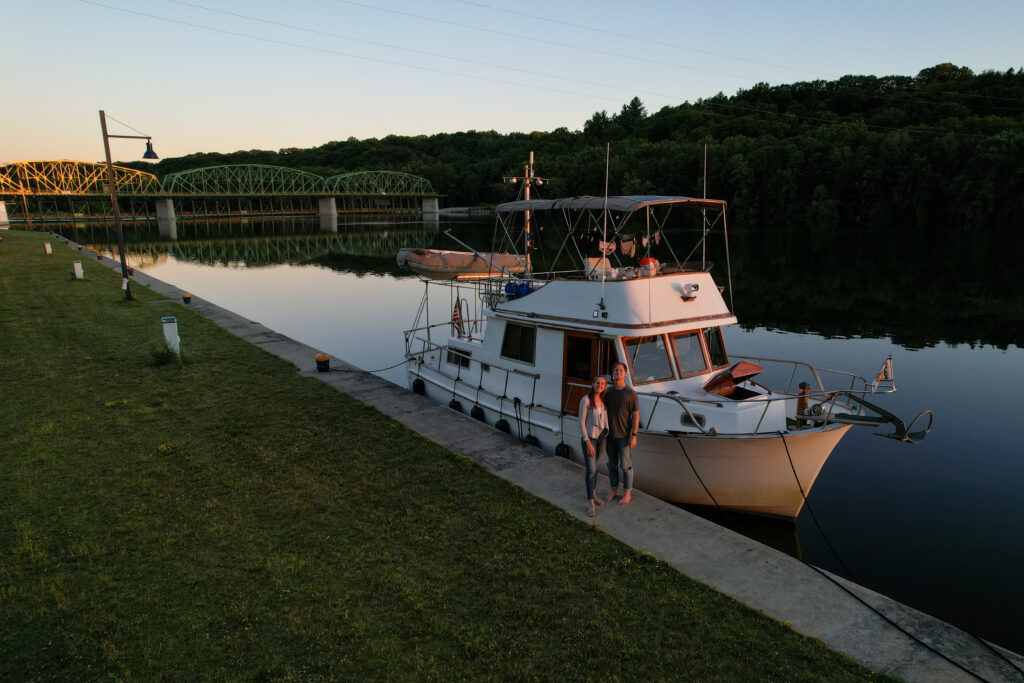
COMMUNICATING WITH A LOCKMASTER
Communicating with a lock master can be daunting before it becomes second nature. Here are our tips on how to communicate with a lock master.
INTENTION
Prior to getting to the lock, it’s important to communicate with the lock master. There are a few ways to communicate with a lock master, including:
- Over VHF radio (our preferred method)
- By phone
- By pulling a signal chain or call button located at the lock entrance
In this communication, it’s important to explain your intention whether you want to lock through as soon as possible, plan to lock through in the morning, or ask about current wait times. Since emergency and commercial vessels take priority over pleasure craft vessels, it’s common for pleasure craft to have to wait for a lock.
EXAMPLE COMMUNICATION
Us: Berkley Lock, Berkley Lock, this is motor vessel PIVOT.
Lockmaster: Berkley Lock
Us: Hi there! We are a 34-foot pleasure craft heading eastbound and are hoping to lock through at your earliest convenience. We are approximately 1 mile away.
Lockmaster: Alrighty, I’ll switch the chamber for you and have it ready.
Us: Thank you so much!
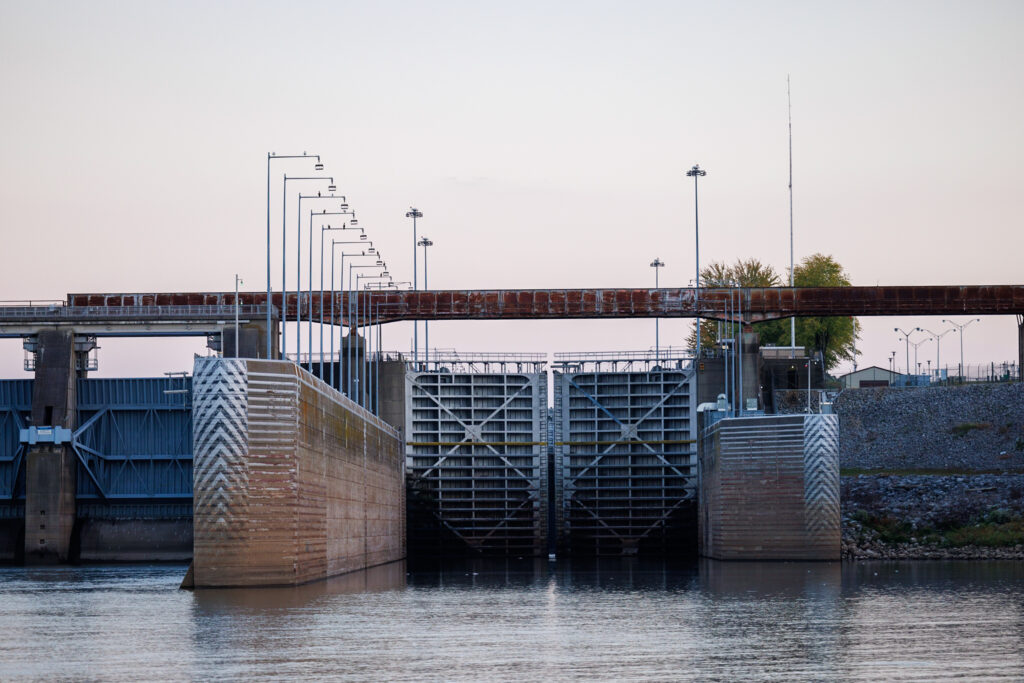
THE 5 STEPS TO LOCKING
1. PREPARATION
It’s important to do a little bit of homework prior to locking. Knowing the governing agencies running the locks will give some important logistics to your locking experience. To start, it’s important to research the hours of operation. Not all locks open and operate during the same hours.
For example, many of the New York State Canals and Parks Canada canals operate in normal business hours. Ranging from 7 am-7 pm depending upon the day and season. Where as some of the USACE locks in the midwest rivers run 24/7 to accommodate for commercial traffic. In addition to hours of operation, it’s important to know the season in which the locks operate.
The locks in the Great Lakes region are closed during the winter. So each year they have a season opening and closing date. The Erie Canal typically opens in mid-May and closes in mid-October, but you should check their website for specifications. Locks may also have multi-month lock closures where the lock will not be in operation due to maintenance. For example, some locks in Illinois will be closed for a few months, opening on October 31st, 2023.
Some of the lock waterways charge boaters to use them. Boaters are charged for a locking pass on the New York State Canals, Parks Canada Canals, and the St. Lawrence Seaway. Passes can be bought online or at the lock stations. Typically, the first lock station in a connected waterway will have passes for you to purchase and use for the remainder of the waterway. The cost of a pass depends on the length of your vessel. For the specific cost of a waterway pass, check the lock agency’s website. This is just part of how much it costs to do America’s Great Loop.
When cruising on the Great Loop, you can locate locks through a variety of means including Navigation apps like Garmin Active Captain and guidebooks, which will include a lot of important information for each lock. All of the waterways have speed limits, specifically near the locks. It’s important to maintain a slow speed for the safety of all boaters.
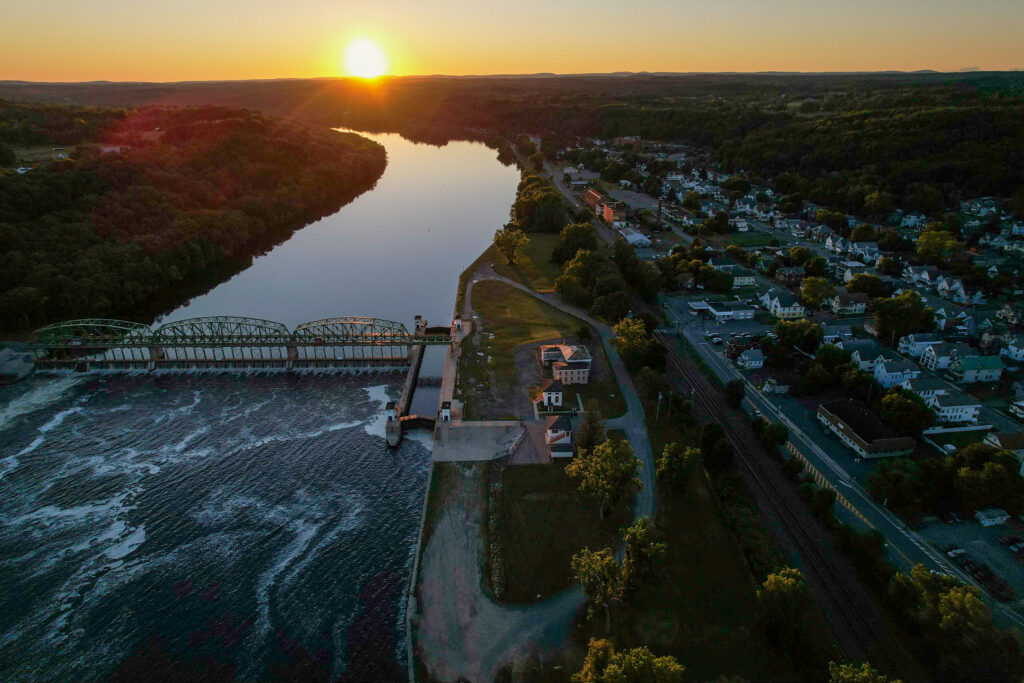
We compiled a list of ALL the Locks on the Great Loop with mile markers, phone numbers, VHF channels, and more. Check out our Great Loop Lock Spreadsheet here!
2. APPROACHING
While approaching the lock, there should be a few things you mind. Many of the USACE locks have commercial traffic. This means that there’s “locking priority,” and we, pleasure boats, are at the bottom of the list. Boats cruise through the lock-in priority order: U.S. Military Craft, Commercial Passenger Craft, Commercial Tows, Commercial Fisherman, and Pleasure Boats. It’s important to have patience while traveling through locks because the lock masters and lock tenders will occasionally make you wait. Having a positive attitude, a kind demeanor, and a smile can go a long way.
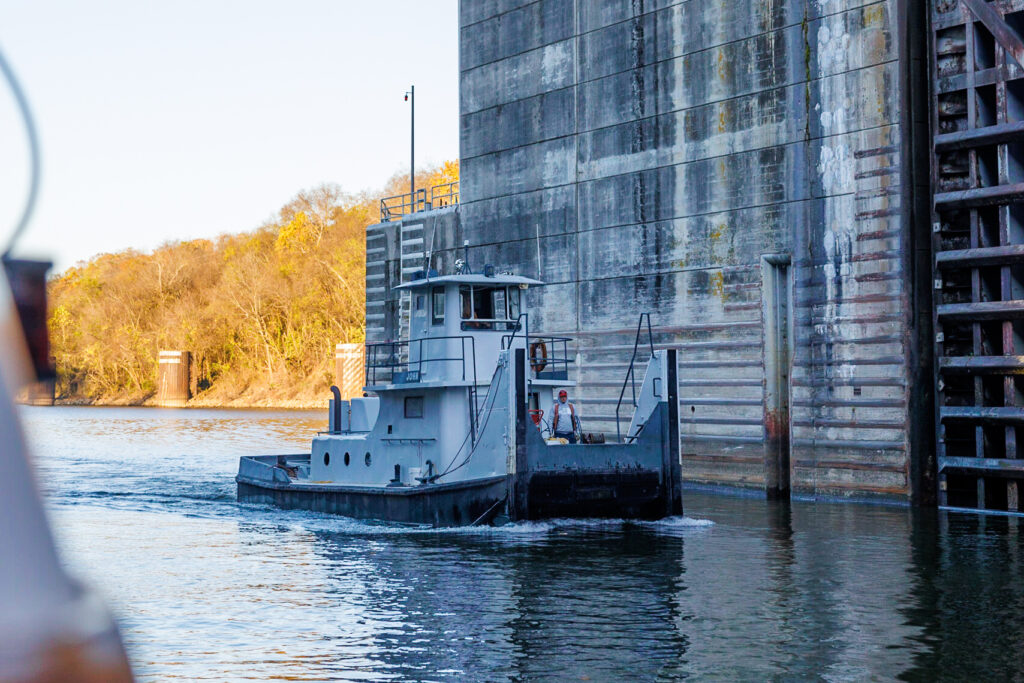
As you get to a lock, you’ll either be able to go right in or you may have to wait. The lock could be full with other boats. Or the lock tender might have to transfer the water to prepare for the direction you’re traveling. Duration waiting for a lock changes based on the lock system. Throughout our experience on the Great Loop, we either waited on a wall (Erie Canal), waited on the painted blue line (Trent-Severn), or held our position (USACE locks). We typically didn’t wait more than 20-30 minutes for lock-throughs on the Erie Canal, Champlain Canal, or Trent-Severn.
On the midwest Rivers, we waited up to an hour for a lock-through. Since it was being used by commercial traffic. Also, since many of the commercial locks were massive, they took a bit longer to turn around. The amount of time you’re waiting at a lock can be aided by calling a lock ahead of time. Communicate with the lock tender that you’re a pleasure boat looking for a lock through. Sometimes lock tenders would tell us to arrive at the lock by a certain time, which we would do and get locked through quickly. Again, a kind, positive attitude went a long way when speaking with the lock tenders.
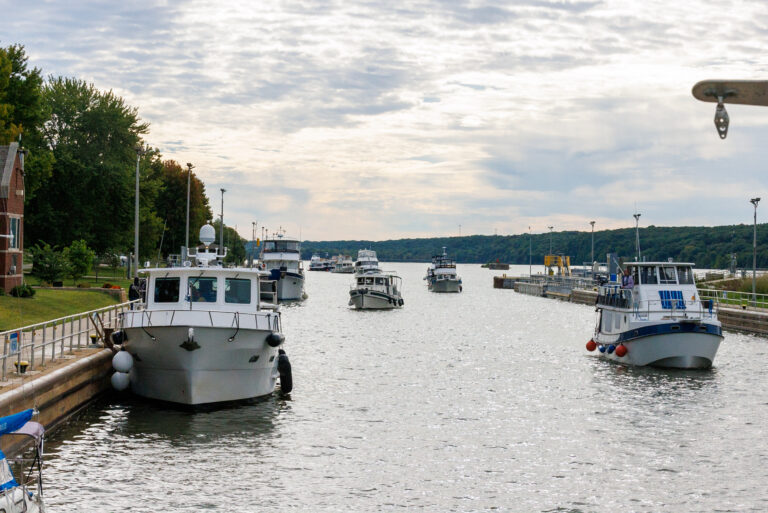
As you’re approaching the lock, look for a flag that will give you some insight into wind direction and strength. Since the lock chambers can amplify the wind in ways that we don’t necessarily expect as it bounces off the lock walls, it’s important to think about these weather factors ahead of time. The image below shows the Canadian flag by the lock.
If you’re cruising through Canada, then you can moor at the painted blue line on one or either side of the lock is an indicator for the lock tender that you want to go through the lock. If the lock is currently being used, tie your boat to the blue line while you wait for the boat to pass through the lock. You may prefer to stay off the wall and wait. But a lot of locks have a dam in close proximity with a lot of current. It is typically much safer to stay on the wall. The image below was taken on the Trent Severn and is an example of the blue line (located on the starboard/right side of the lock) and you can see the Canadian flag to identify wind direction and strength.
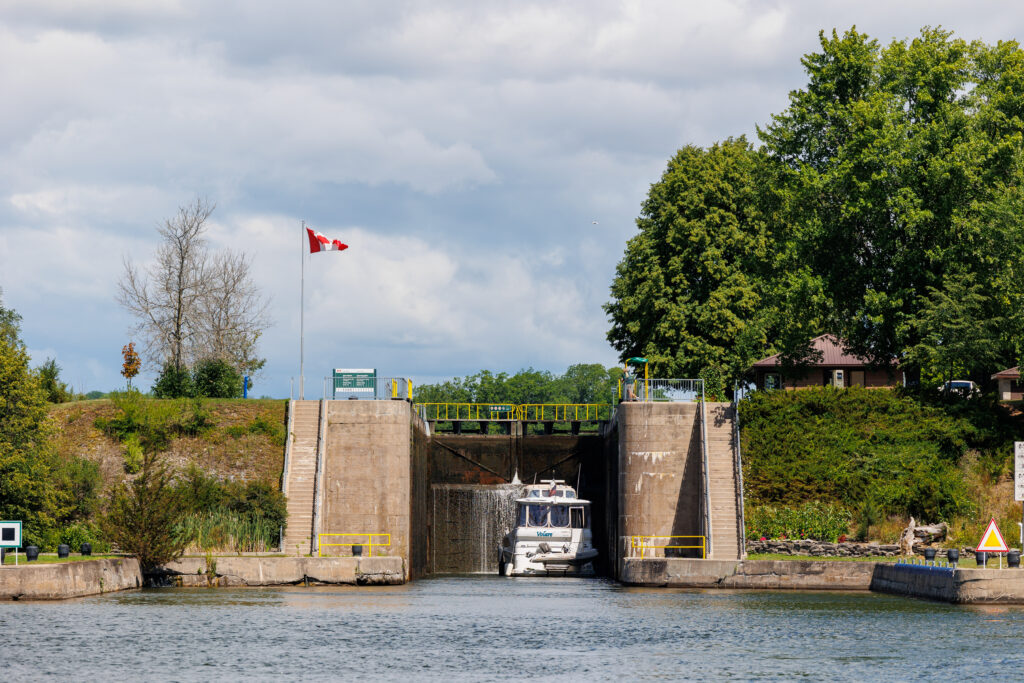
While the captain is managing the vessel, with a slow approach or holding position outside the lock, the first mate is preparing the crew with PFD’s and the vessel with lines, fenders, a boat hook on our bow and stern, gloves, and my rope knife. We put all seven of our fenders out, putting a fender on each handrail. And rotating them between vertical and horizontal to gain as much coverage and protection from the lock wall. We saw that most boats have 3-4 fenders per side of their boat. Including the one large ball fender at their bow. It’s important to have the boat fully ready prior to entering the lock so you’re not holding up other boats once you’re in the lock.
3. ENTERING
Each lock system has its own way to communicate with boaters so that they can enter the lock. This ranges from lights, to “lock doors open”, to horn blasts, or communication over the VHF radio. For the Erie Canal, we used red and green lights as well as radio access to communicate with lock tenders. Sometimes the lights would be out, so we confirmed permission of entry over the VHF with the lock tender. In our experience, the locks on the Trent-Severn, doors were frequently open which meant we could come on in. The lock tenders communicated over a loudspeaker if the vessels were close by and by phone, not VHF. Both the USACE and Tennessee Valley Authority (TVA) used lights, VHF radio, and horn blasts.
Slowly go into the lock in the order you arrived to the lock; no skipping boats in line. Follow the instructions from the lock tender. As you’re entering the lock, the lock tender might communicate with you where they want you to position your vessel. In the USACE locks, they had several floating bollards that aligned with signage with numbers on them. Unless otherwise directed, you will want to go as far forward as you can to leave room for other boats. Practice slow boat, and tight maneuverability skills to align your boat to the wall near the locking mechanisms (line, cable, or floating bollards). Go slow, slower than slow, and only go as fast as you’d like to hit something. Be cautious of debris that has accumulated near the lock doors. You will need to proceed with caution as there could be logs or other large objects submerged.
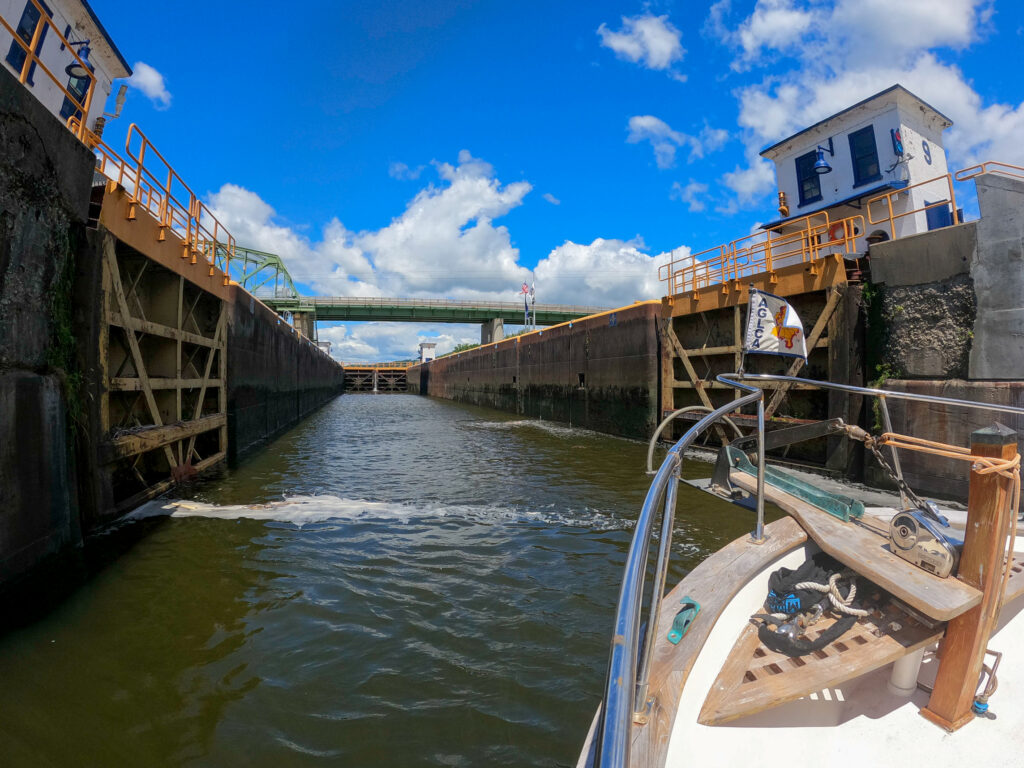
As the captain approaches the line, cable, or floating bollard, the first mate wraps the line around it (or uses the lock’s line around your vessel’s cleat) to make an S shape. Aboard PIVOT, we prioritize getting our stern line on first since our bow thruster makes it much easier to control our bow if something were to happen. Once the stern line is on, I make my way to the bow to do the same maneuver with that line.
In the short period, while we are getting into the lock and getting our vessel and crew situated, I tie the line off to the cleat so we can get the boat situated and then get to our stations (one person at the bow line and the other person at the stern line) for the remainder of the locking process. Some locks will only use a mid-ship line, and in this case, we keep one crew member there while the other roams depending on the current. Once we’re both at our stations, we remove the line from the cleat, put the line into the S shape, and proceed to attend to your lines. It’s extremely important that you do not cleat your line as you’re raising or lowering inside the lock.
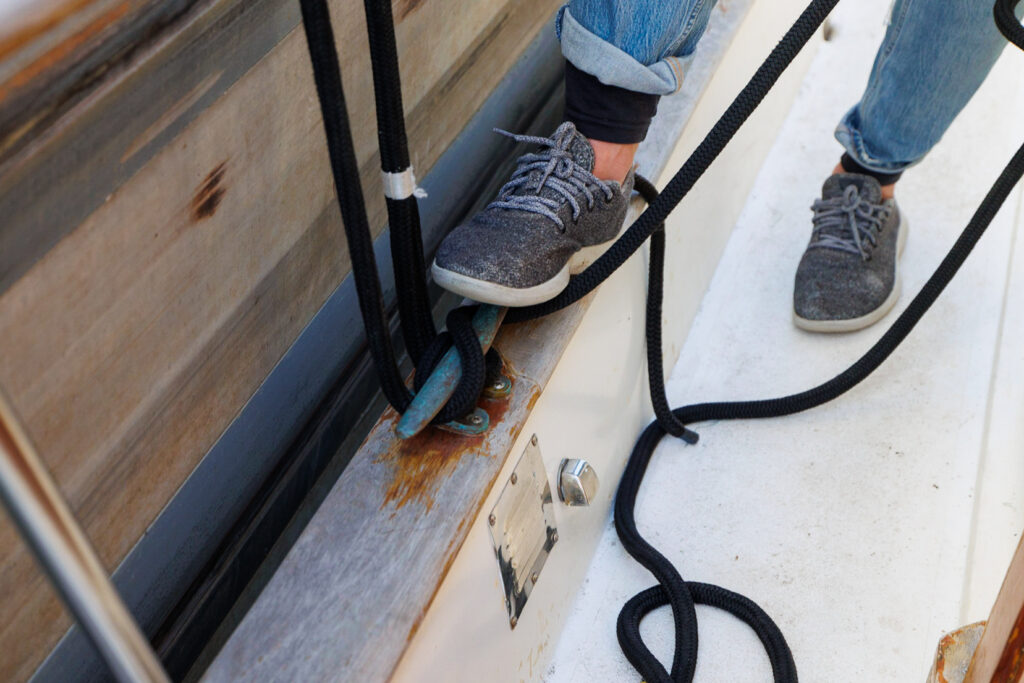
4. LOCKING
The most important thing to do during the locking process is to stay attentive. As the water is rising or lowering in the lock, it’s important to watch your lines and fenders throughout the locking process. You want to avoid the lines or fenders getting caught. For example, if your vessel is lowering in the lock and a line gets caught, it can cause the vessel to hang on the wall, which is incredibly dangerous for you and the other boaters inside the lock. Never cleat your line while the water is rising or lowering!
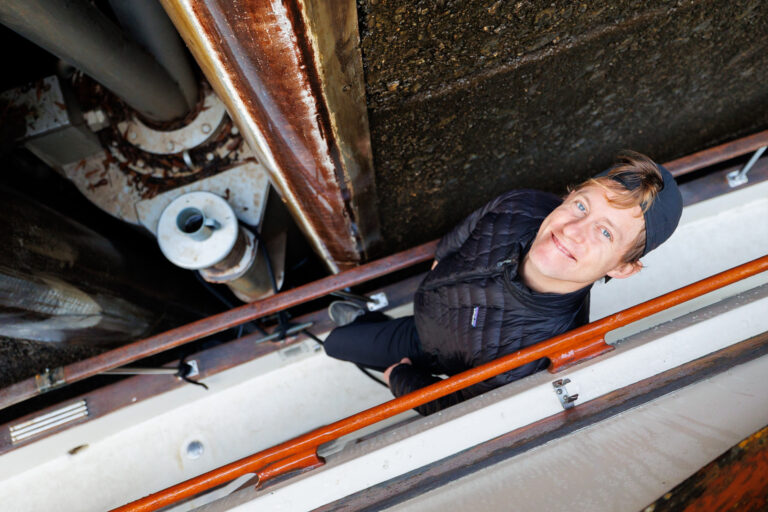
Thankfully in our experience, none of our lines got caught, but we did have a floating bollard that did not move for several minutes as we descended with the water level. Since we were maintaining the lines, we were able to adjust our lines accordingly so it wouldn’t affect our vessel. A few minutes later, the Ballard came rushing down to the water level. It’s something that could have caused a major problem if we weren’t attentive to our lines and were not paying close attention.
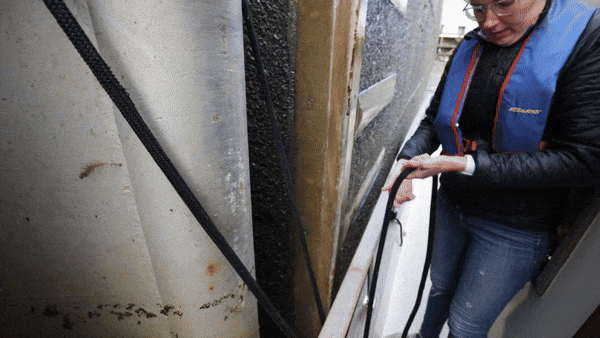
Each locking system varies slightly in what they require, however, it’s a good habit to turn off your engine and turn on your blowers if you have a gasoline engine. Locking through can take anywhere from 15 minutes to 45 minutes. We heard that you can ask the lock tenders for a smooth lock-through, specifically on the Trent-Severn since their locks are hand-operated.
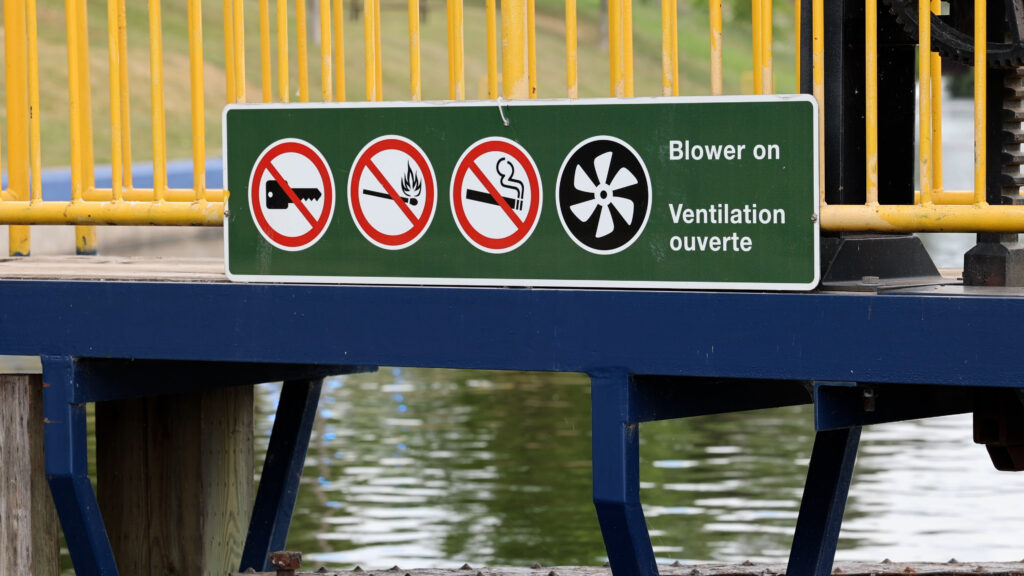
During our time on the loop, rafting was a common technique in locks. We have been both the boat being rafted to (located on the wall) and the rafting boat (tied onto another boat). When preparing to raft, make sure your fenders are out. After the water has been completely raised or lowered, the rafted vessel leaves first.
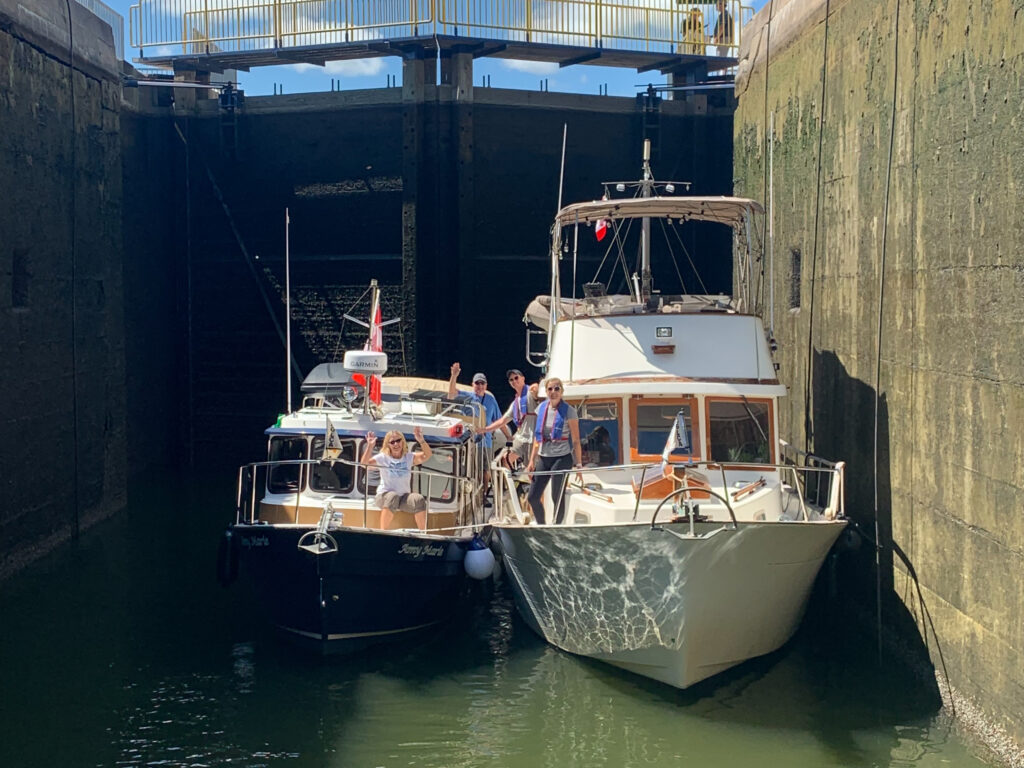
5. EXITING
Exiting a lock is similar to entering a lock. Go slow, show boater etiquette – exiting in the same order you entered unless you’re rafted in which case you’ll exit with the furthest boat on the raft. Keep in mind that Lock Tenders may direct you to leave in a different manner than normal. Keep the same order of boats when traveling between locks that are close together. Be mindful of the speed limits around locks. When leaving a lock heading downstream, be careful of the currents and debris near the dams as the turbulent water can make it difficult to maintain control of your boat.
Throughout our time on the midwest rivers, including the Cumberland River, Tennessee River, and the Tenn-Tom, it was customary for the lock tender to give one final horn blast to communicate to the boaters that we could proceed to exit the lock. Once we were off the wall, Elliot would radio to the lock tender a final thank you and we would be on our way.
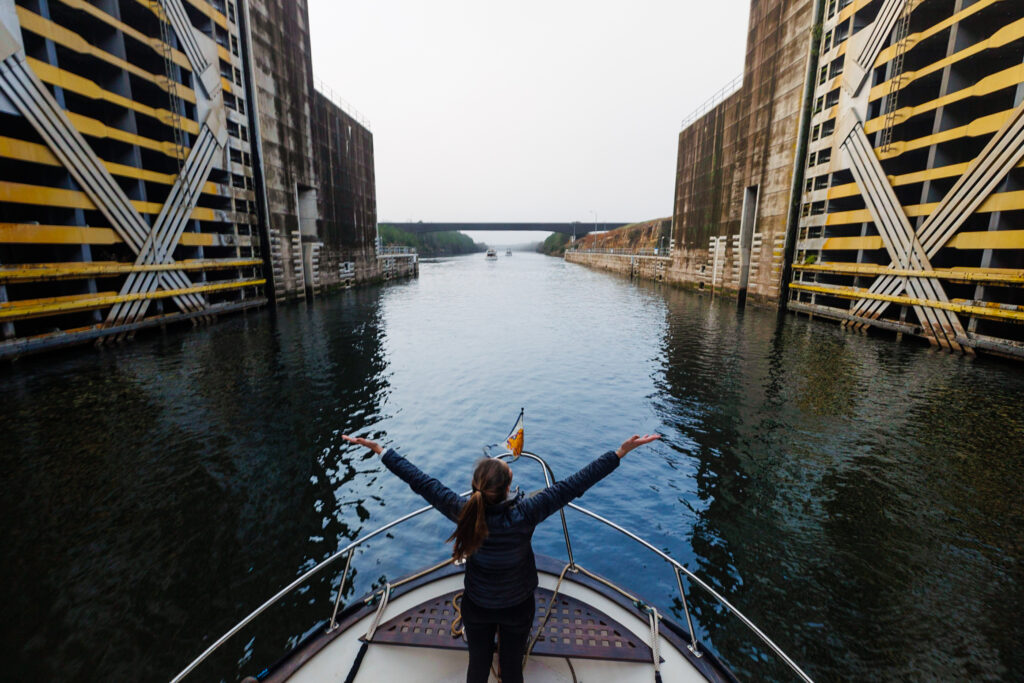
LOCK AGENCIES
Throughout the Great Loop, there are waterways that are managed by different governing agencies. With each agency comes some peculiarities with each locking system. Here is a little background to each of the locks, the managing government agencies as well as some things we experienced. These agencies are organized in the traditional counter-clockwise Great Loop route direction and begin with the locks we started with first, the Dismal Swamp. There are many other lock canals and waterways in the US and Canada, but these are on the main Great Loop route. To watch our full journey around America’s Great Loop, including all of the locks we cruised through, check them out here.

All Great Loop Locks Spreadsheet

We compiled a list of ALL the Locks on the Great Loop with mile markers, phone numbers, VHF channels, and more. Check out our Great Loop Lock Spreadsheet here!
US ARMY CORP OF ENGINEERS – VIRGINIA CUT & DISMAL SWAMP
The US Army Corp of Engineers manages several of the US-based locks, which are organized by region including the Great Bridge Lock (Virginia Cut) and the Dismal Swamp. There is one lock at the southern end of the Dismal Swamp called South Mills Lock and a second at the north end of the lock called Deep Creek Lock. Each lock has a bridge that is opened in conjunction with the lock. Both of these locks use your vessel’s lines to attach to a stationary bollard while your vessel is raised or lowered an average of 8 feet.
The Virginia Cut route has one lock, Great Bridge Lock, and one bridge, which is aptly named Great Bridge Bridge. Unlike the Dismal Swamp route, the Great Bridge Bridge opens on a schedule that determines the time the lock throughs. Great Bridge Lock raises/lowers 1-2 feet depending upon the tides. Since the Dismal Swamp route is much more narrow, a lot of commercial traffic and larger vessels opt to cruise through the Virginia Cut which makes it a bit busier than the Dismal Swamp.




NEW YORK STATE CANALS – ERIE CANAL, OSWEGO CANAL, & CHAMPLAIN CANAL
New York State Canals manages all of the canals in New York with the exception of the first lock at Troy, New York, the Troy Federal Lock, which is operated by the US Army Corp of Engineers. After the Troy Lock, the Hudson River forks into two waterways: the Erie Canal, which heads west to Lake Erie, and the Champlain Canal, which continues north to Lake Champlain. As part of the Great Loop route, we decided to take the “half Erie,” which refers to cruising the eastern half of the Erie Canal up to the Oswego Canal, which leads to Lake Ontario.
The New York State Canal Locks and Dams are painted white with iconic yellow and navy blue accents. The last lock-through was 30 minutes before they closed. The staff people are very friendly and gave us great recommendations for the local areas. These locks typically require an annual canal pass, however, they waved the pass in 2022 when we cruised on these canals. Lock walls were free to stay overnight, with permission from the lock tender.





ST. LAWRENCE SEAWAY – ST. LAWERENCE RIVER & WELLAND CANAL
The St. Lawrence Seaway manages the St. Lawrence river between Montreal to Lake Ontario as well as the Welland Canal between Lake Ontario and Lake Erie. Two out of seven locks are maintained by the United States and the remaining five out of seven locks are maintained by Canada. The Welland Canal consists of eight locks which are all operated and maintained by Canada. Although we did not cruise through these locks, we read reviews and heard from other loopers that vessels were required to have a scheduled appointment time for pleasure craft. Upon arrival at the lock, vessels were required to dock their boats on a wall, get off their boats to call the lock tenders via a landline phone at the station, and pay for their lockage. The specific instructions for pleasure craft arrival and transiting through the canal can be found on the St. Lawrence Seaway website.
PARKS CANADA – CHAMBLY CANAL, RIDEAU CANAL, & TRENT-SEVERN WATERWAY
Parks Canada operates the waterways in Canada, including the Chambly Canal, Rideau Canal, and the Trent-Severn Waterway. The Chambly Canal connects Lake Champlain with the St. Lawerence River and Montreal with 12 locks. The Rideau Canal is part of their National Historic Sites and connects Ottawa to Kingston, Ontario with 49 locks. The Trent-Severn Waterway is also a National Historic Site and connects Trenton (Lake Ontario) with Port Severn which is at the bottom of the Georgian Bay (Lake Hereon) with 43 locks. In our experience, this was by far the kindest set of locks. The lock tenders were almost like travel guides as they would share local recommendations with us and went above and beyond anything we needed.
The Parks Canada locks were very consistent in their systems. Boats would wait on the painted blue line to enter a lock. These canal systems required a lock pass, available for purchase online or at any lock station. Lock walls were available for overnight stays and were very affordably priced at CA$1/foot or you could purchase an overnight mooring pass for the entire season, which were available on their website or at any lock station. For boaters planning on cruising through these waterways, you can save 20% discount on a seasonal lockage permit and a 10% discount on the seasonal mooring permit by purchasing a pass before March 31st as part of their early bird sale.
You can prepay for overnight moorings or you can save your receipts. As you stay at the number of moorings, you would have prepaid for, they will automatically convert your pass to the unlimited pass. Some lock stations had power but most lock stations were at these super cute parks with beautiful flowers and washrooms. If we did the Great Loop again, we would definitely take the Champlain route up to the Chambly Canal and visit Montreal, Ottawa, and the Rideau Canal based on how much we loved the Canadian canals.




US ARMY CORP OF ENGINEERS – CHICAGO RIVER, CAL-SAG, ILLINOIS RIVER, MISSISSIPPI RIVER, & OHIO RIVER
Once you’ve successfully cruised through the Great Lakes and you arrive to Chicago, you have two routes; one goes down the Chicago River through the incredible downtown Chicago or through the Cal-Sag which is south of Chicago and has less overhead clearance restrictions. Each route includes one lock before meeting up together at the Chicago Sanitary and Ship Canal. The US Army Corp of Engineers manages the Illinois River locks, which include seven locks, one lock on the Mississippi River, and one last lock on the Ohio River. There are many more locks as part of the Mississippi River and Ohio River, however, these are the only locks on the Great Loop route.
This section will contain your first set of large commercial locks and will require a bit more planning. Many tug and barges require multiple lock-throughs to move past a lock, ushering one section of their load at a time. Due to this, there may be multiple-hour wait times depending on how long it takes for the lock to turn around. You will want to call ahead and, if possible, travel with a flotilla of other boaters.
This section has also had a lot of planned maintenance periods in recent years. In 2023, Brandon Road, Dresden Island, and Marseilles Lock and Dam are all having a full closure from June 1 to September 30. For more information, visit their website here. You will want to research this in your preparation stage.




TENNESSEE VALLEY AUTHORITY (TVA) – CUMBERLAND RIVER & TENNESSEE RIVER
The Tennessee Valley Authority or TVA in conjunction with the USACE manages the locks on the Cumberland River and Tennessee River. TVA has a great, simple video explaining how the lock system works. These locks are organized into the USACE Nashville District. This section includes a total of 13 locks, but most of them are located on the Cumberland River to Nashville, TN and the Tennessee River to Knoxville, TN. You will see some very large lifts here, including a 93’ raise at the Wilson Lock on the Tennessee River.





US ARMY CORP OF ENGINEERS – TENNESSEE TOMBIGBEE WATERWAY & TOMBIGBEE-BLACK WARRIOR WATERWAY
As you make your way further south, you’ll enter the Tennessee Tombigbee and the Tombigbee-Black Warrior Waterway which are managed by the US Army Corp of Engineers. Also known as the Tenn-Tom, this 234-mile artificial waterway connects the Tennessee River with the Tombigbee-Black Warrior River and is known as the “largest civil works project ever constructed in the United States.” This section includes a total of 16 locks over the course of 300 miles. The Tennessee Tombigbee Waterway connects with the last two locks on the Tombigbee Black Warrior Waterway before getting to Mobile, Alabama.




US ARMY CORP OF ENGINEERS – OKEECHOBEE WATERWAY
The last set of locks on the Great Loop is the Okeechobee Waterway, which crosses through the center of Florida at Lake Okeechobee from Fort Meyers to Stuart. This waterway includes five locks which are also managed by the US Army Corp of Engineers and operate year-round (with the exception of lock closures for maintenance). The waterway travels to Lake Okeechobee to an elevation of 18 feet above sea level.
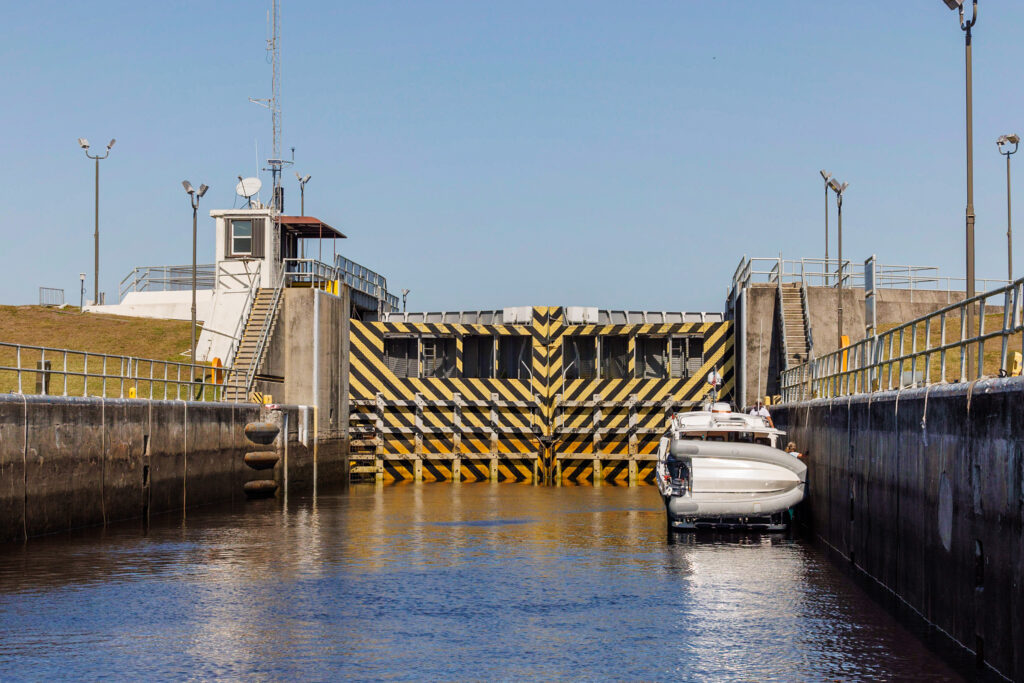
UNIQUE LOCKS AROUND AMERICA’S GREAT LOOP
America’s Great Loop is a bucket list item for many boaters around the world. One of the many highlights of this journey are the incredible locks that you go through. Just like cruising next to the Statue of Liberty in New York or cruising down the Chicago River, the locks on the Trent-Severn Waterway are once-in-a-lifetime experiences for many.
PETERBOROUGH LIFT LOCK
The highest hydraulic lift lock in the world raising boats a total of 65 feet (20 meters), the Peterborough Lift Lock is incredibly unique. Located at lock #21 in Peterborough, Ontario on the Trent-Severn waterway, the Peterborough Lift Lock was first built in 1904. Unlike a typical lock that has one chamber, which has water pumped in and out of it, the Peterborough Lift Lock has two basins. Both of the basins are connected through an underground hydraulic pump. When the lock tender releases 1 foot of water from the upper basin into the lower basin. Due to pressure and gravity, the upper basin gently moves down while the lower basin moves up. The lock process takes about 2 minutes. Although the entire process for boats to securely enter and exit the lock takes longer. Watch our experience cruising through the Peterborough Lift Lock on YouTube.



BIG CHUTE MARINE RAILWAY
The Big Chute Marine Railway is a one-of-a-kind lock that is located on the Trent-Severn Waterway at lock #44. This unique “lock” was built in 1917 to keep an invasive species of sea lamprey from further contaminating the Great Lakes and was rebuilt in 1978 to accommodate for larger vessels. Boats are carried over land in a cradle, similar to those used for hauling boats out at boat yards, for a total height change of about 60 feet (18 meters). The Big Chute usually operates by moving two looper-sized boats at a time. This lock is operated by the Parks Canada staff who are highly trained and specialized for moving boats safely across this lock. Watch our experience cruising through the Big Chute Marine Railway on YouTube.
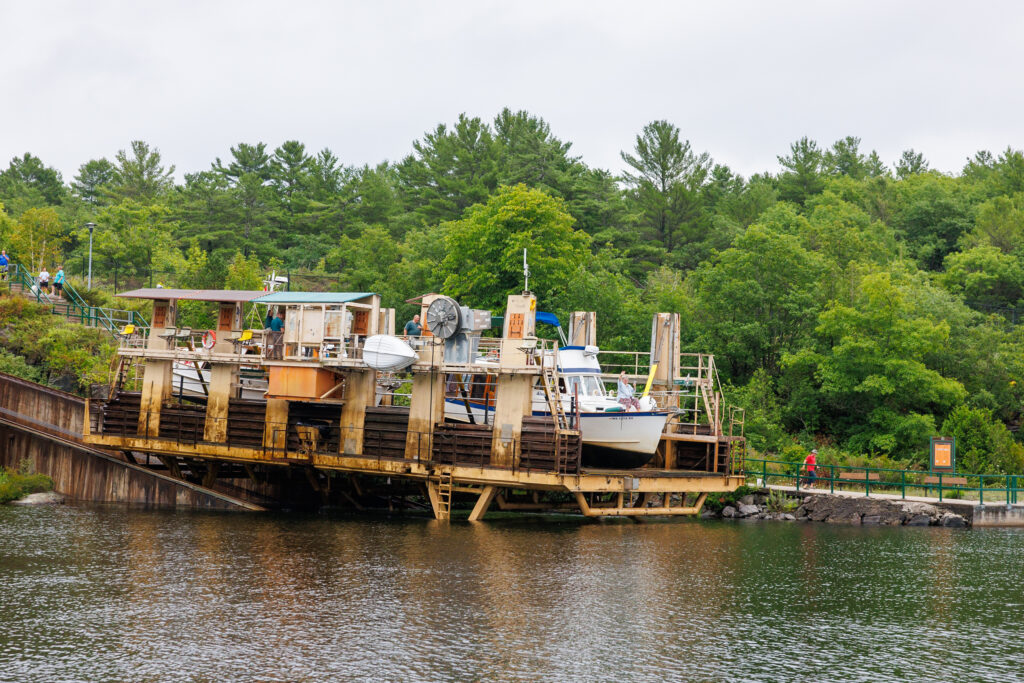
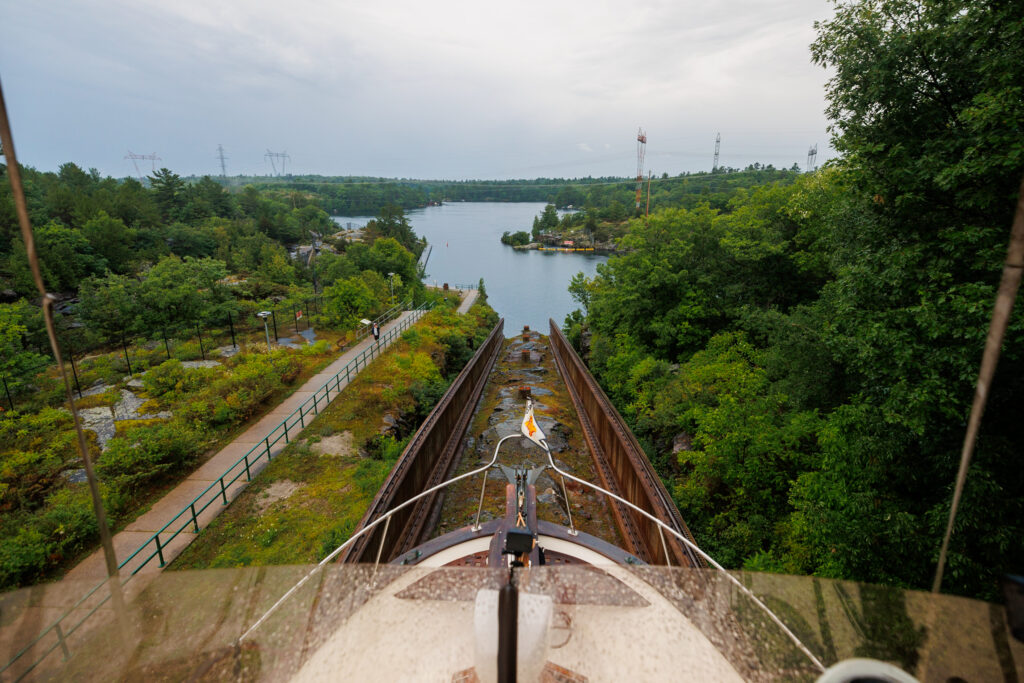
COST OF LOCKING
The only waterway we experienced on the Great Loop that required a canal permit was Parks Canada for the Trent-Severn Waterway and the Rideau Canal. The New York State Canal System did not charge us any fee in 2022. However, we understand fees are usually based on the size of your vessel. In addition to the Trent-Severn Waterway, Parks Canada also charges for the Rideau Canal. We chose to skip the Rideau Canal and only bought a one-way waterway pass, which you can see in our July Great Loop Expense Report.
Boaters are able to purchase a two-way pass if they plan on slowly exploring these waterways in a boating season. And if you plan to go north and south through the lock systems. Boaters can also choose to purchase overnight mooring or dockage passes based on the size of their vessel. We opted to not purchase this pass. But if we had cruised on the Rideau Canal, it would have been beneficial for us to pay for it. Parks Canada has a great rule that if you stay overnight on their lock walls, paying per night, then you can save up your receipts and if you get up to 10 nights, they’ll upgrade you to the overnight mooring pass only charging you the difference for the pass.
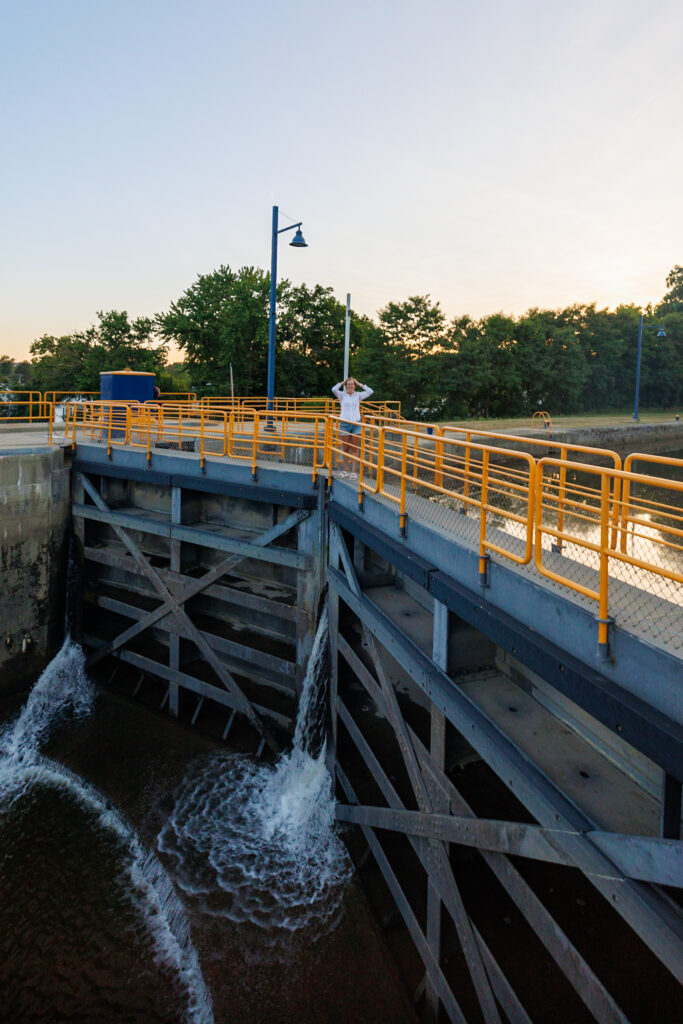
The St. Lawrence Seaway and Welland Canal also charge pleasure boaters. It was unclear to us if each lock was $30, or if traveling through all 7 locks was $30. You can purchase your pass online or pay by cash, both USD or CAD are acceptable, at the lock stations. Either way, you can find more information on the St. Lawrence Seaway website and in their Pleasure Boats Guide.
Our Locking Resources

Download and print our FREE Locking Checklist to keep at your helm for your own boating adventures. It includes the Locking Gear and the Five Steps to Locking.

Check out our All Great Loop Locks Spreadsheet, which compiles all of the locks on the Great Loop route into one document, including mile markers, locations, phone numbers, and more.
Watch How to Lock a Boat on YouTube
Watch our “How to Lock” video on YouTube. We go over all five steps as we travel through nine locks in one day on the Trent Severn Canal. We include our tips and trips and give examples of previous locking experiences:
We hope this post provided you with some insightful information on how to lock with confidence. Comment below if you found this information useful. Or if there’s something we missed that would be beneficial for others to learn.
Save for Later
Save this to Pinterest to read again later!

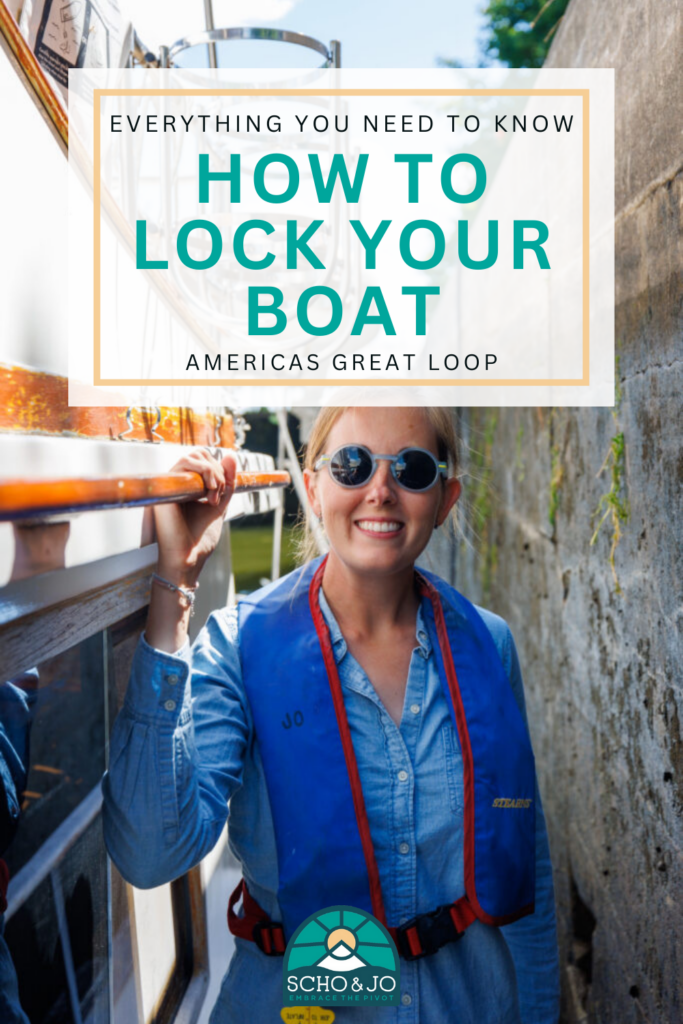
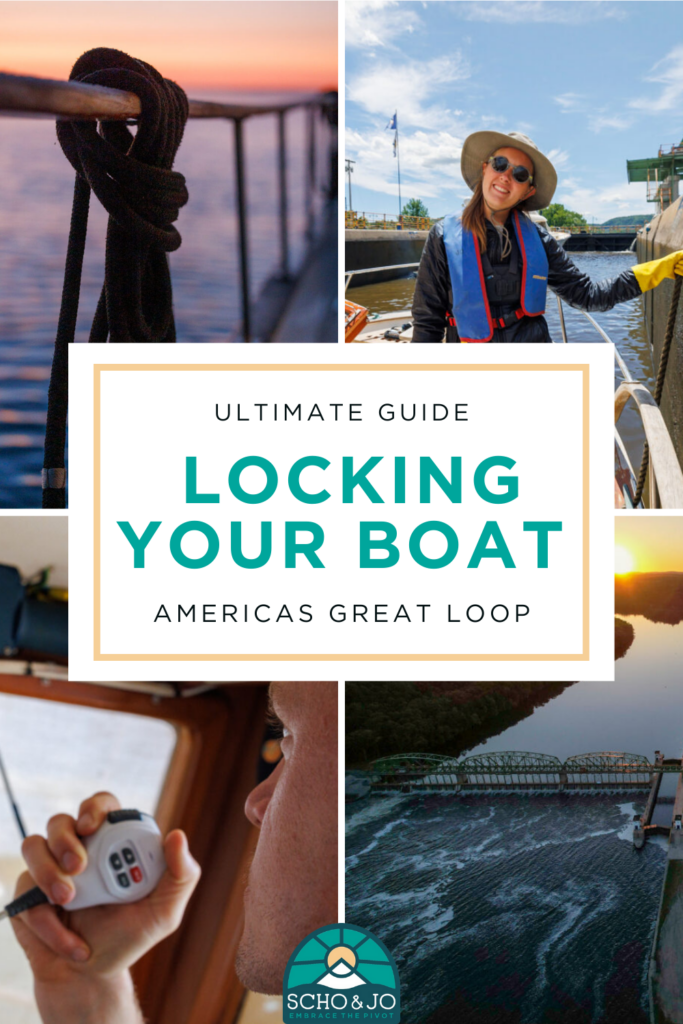

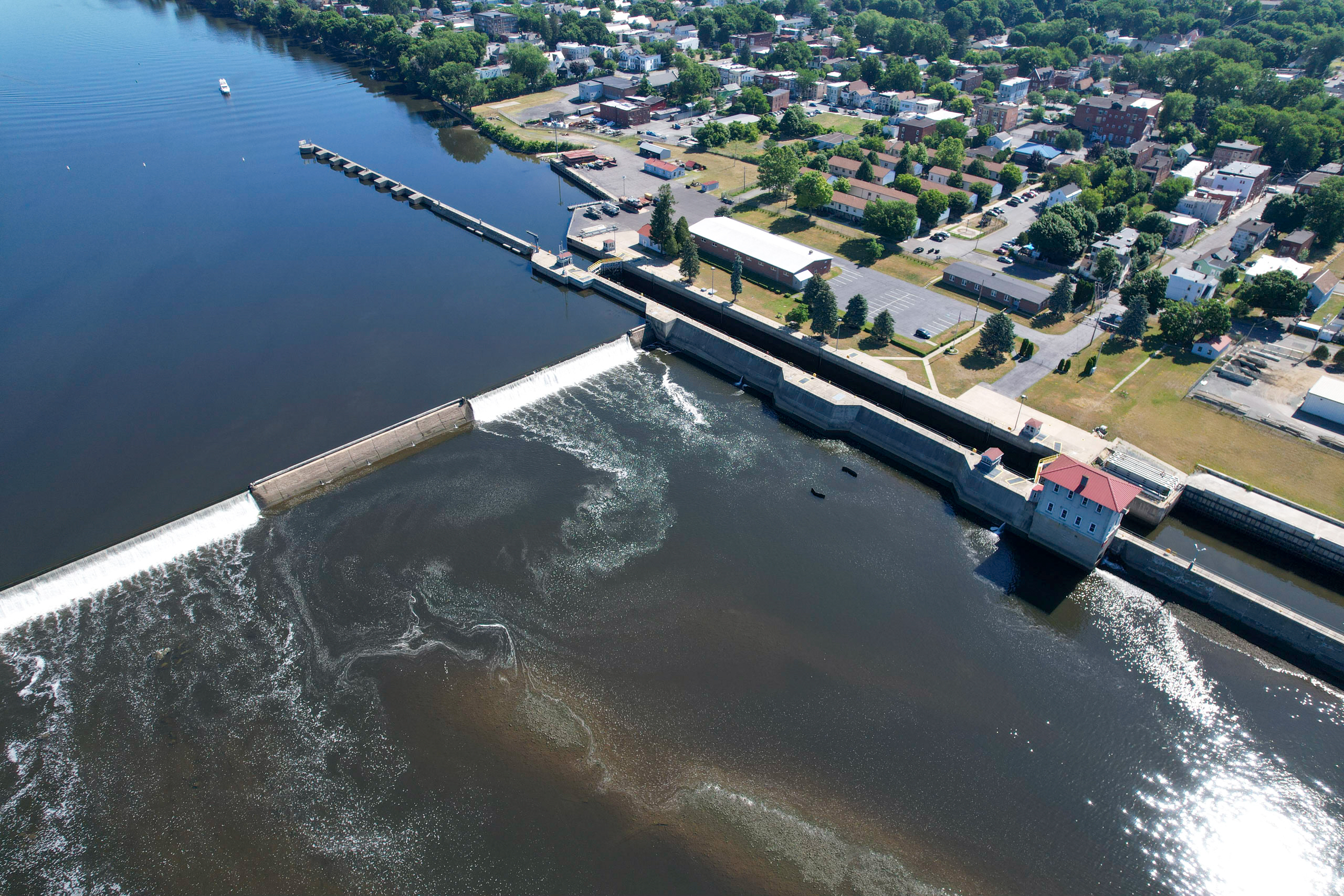





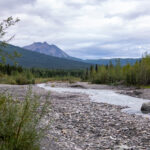

Leave a Reply